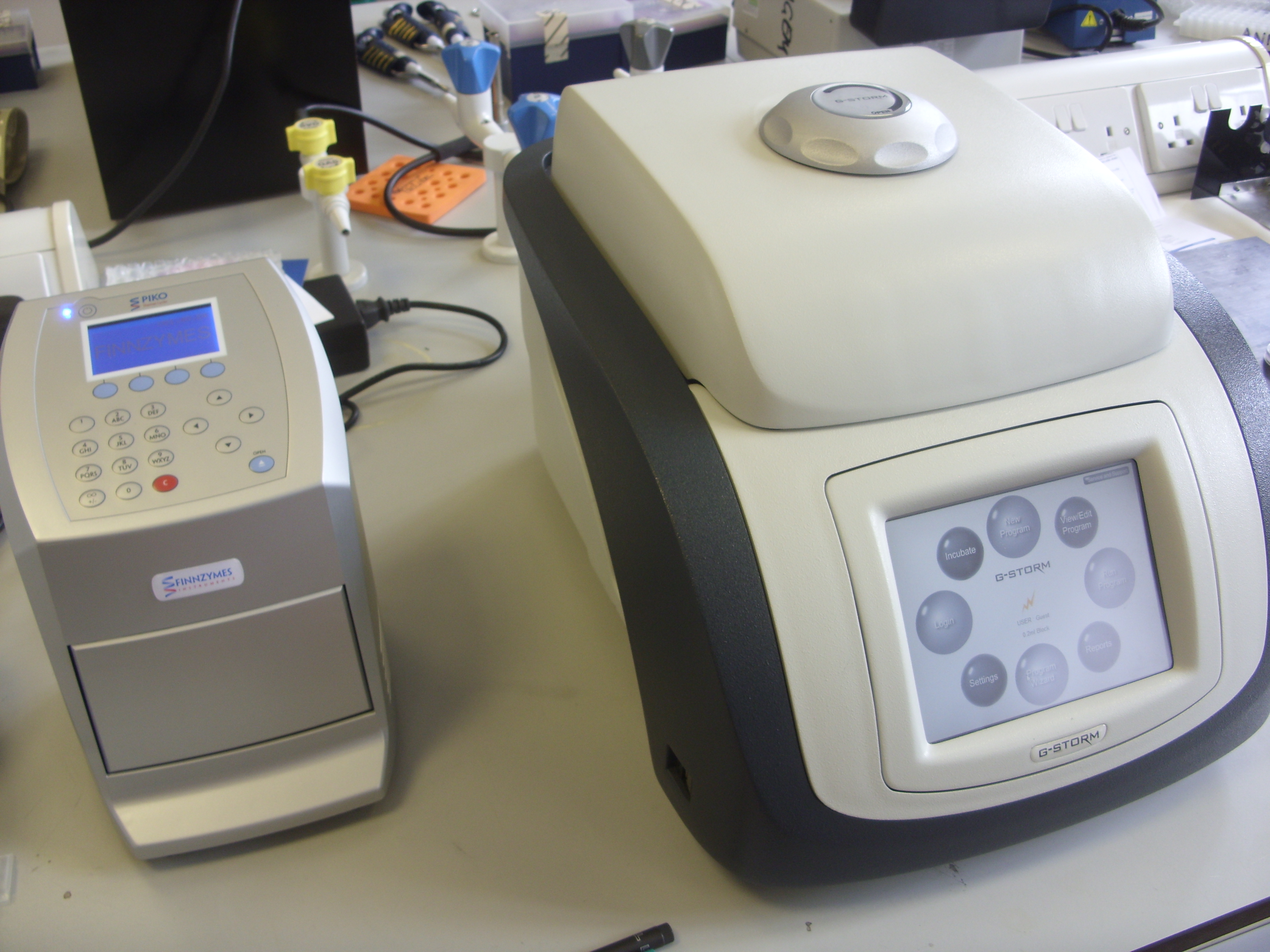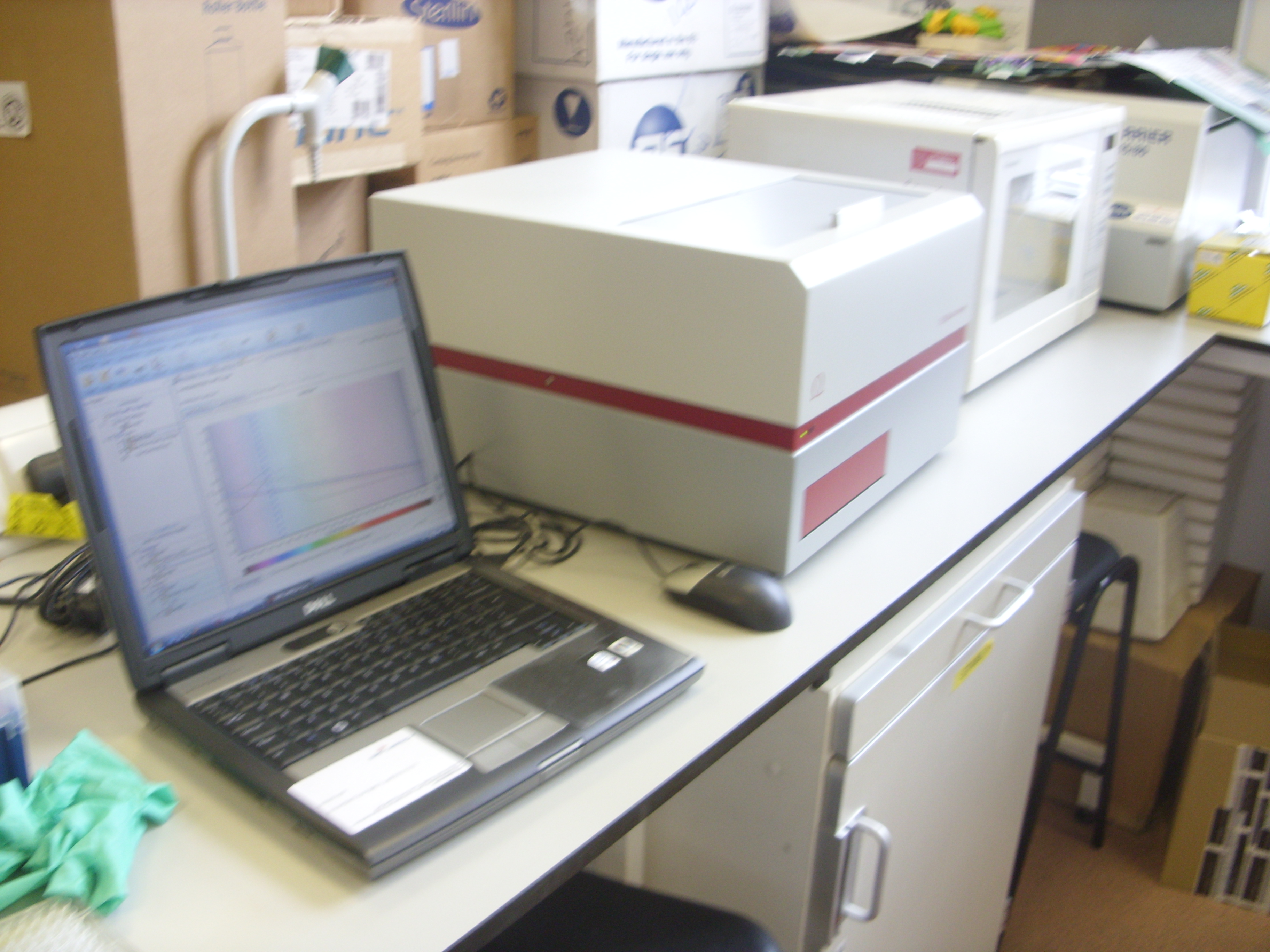Team:Cambridge/Protocols
From 2009.igem.org
Categories :
Project :
-
Overview
Sensitivity Tuner
--- Characterisation
--- Modelling
Colour Generators
--- Carotenoids (Orange/Red)
--- Melanin (Brown)
--- Violacein (Purple/Green)
The Future
Safety
Notebook :
Team Logistics :
-
Protocols
Stock List
Research
Shared Links and Help
Protocols
Producing competent cells
Starting from a single colony on a plate:
- Transfer colony into 50ml liquid LB media and leave in a 200rpm shaking incubator overnight
- Take 10ml of the culture and innoculate into one litre LB and grow in shaking incubator until OD600 of 0.2-0.3 (4 hours?)
- Put culture on ice for 30 minutes
- Centrifuge at 4000g for 6 minutes
- Remove supernatant and resuspend cells in an equal volume of ice-cold 0.1mM HEPES
- Repeat centrifugation
- Resuspend cells in 0.5 volume ice-cold 0.1mM HEPES
- Repeat centrifugation
- Resuspend cells in ice-cold 10% glycerol (20ml)
- Combine to form two tubes of 40ml glycerol
- Repeat centrifugation
- Resuspend in ice-cold glycerol (3ml)
- Divide cells into 100ul aliquots and store at -80
(Cells should be at a final volume of ~3 x 10^10 cells.ml^-1)
Competent cells Transformation
- Electrocompetent cells thawed on ice
- Prepare vector DNA on ice
- Biobricks
- With pipette tip, punch hole through foil cover into designated well
- Add 20uL DIW
- We will be removing about 5uL; the rest needs to go in an eppendorf, labeled with biobrick number, and stored at -20°C
- Violacein and melanin need to be thawed
- Vector DNA pipetted into chilled 1mm separation electrocuvette = 4 total
- 5uL of biobricks
- 0.5uL of melanin and violacein plasmid
- Add 45 uL Competent cells
- Tap electrocuvette gently to evenly spread mixture in the electrocuvette gap with no air bubbles
- Thoroughly dry the cuvette
- 1.68 kV passed across cuvette, 5.1-5.4 time constant at 200 ohms and 25 uF
- Add 0.25 mL SOC liquid medium to electrocuvette
- Incubate electrocuvettes at 37 degrees C for 60 minutes
- Pipette 150uL onto a (warmed) selective LB agar plate, spread with blue spreader
- Orange genes biobrick: ampicillin
- Promoter for orange genes biobrick: ampicillin
- Melanin: ampicillin, copper, and tyrosine
- Violacin: trimethoprim
- Do 1:10 dilution with SDW into a new eppendorf
- Pipette 150uL onto a selective LB agar plate, spread with blue spreader, 4 separate inoculums
Carotene extraction with acetone
Adopted from Yuan et al. (2006):
1. Incubate E.coli in 5ml LB with antibiotics at 37 oC for 20 hours.
2. Harvest cells using centrifugation at 4000 rpm for 10 minutes.
3. Re-suspend cells in 300 ul acetone and vortex for 5 minutes*** (***: original protocol recommended "Homogenise cells with glass beads in Bead-Beater for 30s (Biospec products)", but we did not have the equipment. Vortex is used for homogenisation instead).
4. Centrifuge sample at 14,000 rpm for 1 minute. Collect supernatant.
5. Measure absorption using spectrophotometer at 450 nm. Normalise data to cell density (OD 600 nm). This is performed using Omega Microplate Readers from BMG-Labtech.
CAUTION: Acetone may corrode plastic microplates and cause severe damage to the equipment if left in the plate reader for too long. With microplate readers, dilute acetone extract 10 times with water (to give 200ul) before loading into plastic wells.
Agarose gel electrophoresis
Gel preparation
To prepare 1% agarose gel (say 200ml), add 2g of agarose powder to 200 ml of 1X TAE buffer (obtained by diluting 10X TAE stock buffer with water) and heat in microwave until all powder desolves. Gel stains should be added when the agarose becomes cool enough to touch.
For ethidium bromide gels, add 2 uL EtBr to 20 mL of agarose (makes 1 gel).
Electrophoresis setting
For electrophoresis, set constant voltage at 80V (with current at approximately 3 mA) and run for 30--60 minutes (or until sufficient separation of DNA).
Finnzymes Phusion (TM) PCR
Shuna's protocol
PCR Master Mix
- 25ul 2x Phusion Master Mix
- 0.5uM of each primer
- ~5ng of DNA
- Make up to 50ul with SDW
PCR Cycle
Thirty seconds at 98 degrees
Thirty cycles:
- 98 degrees for 5-10 seconds
- 67 degrees for 10-30 seconds (depending on primer)
- 72 degrees for 30 seconds/kb
Final extension at 72 degrees for 5-10 minutes Hold at four degrees.
James's protocols:
Phusion master mix
2.5 uL forward primter
2.5 uL reverse primer
0.5 uL template
25 uL 2x Phusion master mix
optional 1.5 uL DMSO
make up to 50 uL with SDW
Using Phusion enzyme
2.5 uL forward primter
2.5 uL reverse primer
0.5 uL template
1 uL dNTPs
0.5 uL Phusion polymerase
10 uL x5 buffer (use buffer GC for high GC content, has shown to give higher product yeilds)
make up to 50 uL with SDW
PCR procedures
For high accuracy sequence PCR
- Use the Phusion set from Finnzymes
- 50ul solution
- Can alter conditions for optimisation
For verification of plasmid presence/length
- Use TAQ polymerase and buffer from stores
- 20ul solution
- Run with standard procedure as follows (from James) for Colony PCR
- Reaction Mixture
- Template: 1 uL from O/N culture (1-2 uL if colony picked straight from plate into water)
- VF2: 1uL
- VR: 1uL
- Eco-Taq: 0.2 uL
- 10X buffer: 5 uL
- dNTPs: 0.4 uL (stock is 10 mM)
- make up to 20 uL volume with H20
- Reaction procedure
- 95 degrees C for 2 minutes
- 33 cycles of:
- 95 degrees C for 30 seconds (denaturation)
- 65 degrees C for 30 seconds (annealing)
- 72 degrees C, 1000bp/min (elongation)
- 72 degrees C for 5 minutes
- hold at 4 degrees C
Gels
- Run on EtBr for good quality viewing (make agarose gel). This is viewed in the red-room downstairs.
- Run on SYBR-safe gel if the DNA is required. This can be viewed under blue light in the covered dark-area.
Glycerol Stocks
For -80
Cells in 10-15% glycerol, 1:4 ratio of glycerol:culture
- 0.5mL 80% glycerol
- 2mL fresh culture
For -20
Cells in 20-40% glycerol, 1:1 ratio of glycerol:culture
- 1mL 80% glycerol
- 1mL fresh culture
Add cells to glycerol, vortex, put on ice immediately, then store.
 "
"

